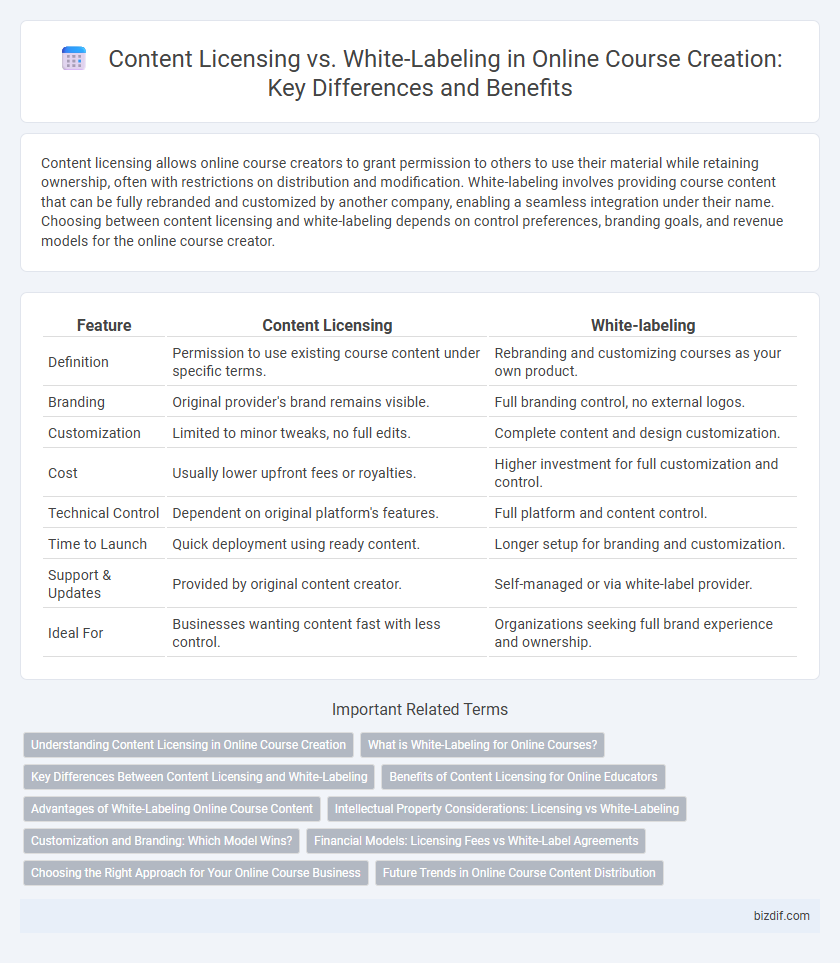Content licensing allows online course creators to grant permission to others to use their material while retaining ownership, often with restrictions on distribution and modification. White-labeling involves providing course content that can be fully rebranded and customized by another company, enabling a seamless integration under their name. Choosing between content licensing and white-labeling depends on control preferences, branding goals, and revenue models for the online course creator.
Table of Comparison
| Feature | Content Licensing | White-labeling |
|---|---|---|
| Definition | Permission to use existing course content under specific terms. | Rebranding and customizing courses as your own product. |
| Branding | Original provider's brand remains visible. | Full branding control, no external logos. |
| Customization | Limited to minor tweaks, no full edits. | Complete content and design customization. |
| Cost | Usually lower upfront fees or royalties. | Higher investment for full customization and control. |
| Technical Control | Dependent on original platform's features. | Full platform and content control. |
| Time to Launch | Quick deployment using ready content. | Longer setup for branding and customization. |
| Support & Updates | Provided by original content creator. | Self-managed or via white-label provider. |
| Ideal For | Businesses wanting content fast with less control. | Organizations seeking full brand experience and ownership. |
Understanding Content Licensing in Online Course Creation
Content licensing in online course creation allows educators to grant permissions for their course materials to be used by others under specific terms, ensuring intellectual property rights are protected while enabling wider distribution. Licensing agreements typically define the scope, duration, and usage limitations, facilitating controlled access and monetization of digital content. Understanding these aspects is crucial for creators to maximize revenue streams and maintain content integrity in a competitive online education market.
What is White-Labeling for Online Courses?
White-labeling for online courses involves creating educational content that is rebranded and resold by other businesses as their own without revealing the original creator. This approach allows companies to offer customized training solutions under their own brand identity, enhancing credibility and customer loyalty. White-labeling differs from simple content licensing by providing a full branding experience and often includes customizable course elements such as logos, color schemes, and user interfaces.
Key Differences Between Content Licensing and White-Labeling
Content licensing grants permission to use and distribute pre-existing course material under specific terms, allowing limited modifications while maintaining the original creator's branding and copyright. White-labeling enables rebranding of the course content entirely, giving the licensee full control over presentation, branding, and marketing as if it were their own product. Key differences include ownership rights, customization levels, and brand visibility: content licensing restricts branding changes, whereas white-labeling offers complete brand integration and customization freedom.
Benefits of Content Licensing for Online Educators
Content licensing enables online educators to retain ownership while granting others the right to use their course materials, facilitating wider distribution without losing control. This approach generates ongoing revenue streams through licensing fees and enhances brand credibility by associating with reputable platforms. Content licensing simplifies content management by reducing the need for customization compared to white-labeling, allowing educators to focus on creating high-quality learning experiences.
Advantages of White-Labeling Online Course Content
White-labeling online course content allows businesses to brand and customize educational materials as their own, enhancing brand identity and customer loyalty. It offers greater control over course presentation and marketing while eliminating the need for content development from scratch. This approach accelerates time-to-market and provides a scalable solution for companies seeking to expand their online learning portfolio efficiently.
Intellectual Property Considerations: Licensing vs White-Labeling
Content licensing grants course creators the right to use or distribute intellectual property while retaining ownership, ensuring control over how the content is modified or shared. White-labeling transfers more extensive branding rights, allowing partners to rebrand and present the course as their own, which may involve relinquishing certain intellectual property claims. Understanding the distinctions between licensing agreements and white-labeling contracts is crucial for protecting copyrights and defining usage rights in online course creation.
Customization and Branding: Which Model Wins?
White-labeling offers superior customization and branding opportunities, allowing businesses to fully rebrand and tailor the course content to reflect their unique identity, enhancing customer trust and engagement. Content licensing typically limits customization to predefined parameters, restricting the ability to modify the content's look and feel, which can dilute brand distinction. For online course creators seeking complete brand integration and personalized user experience, white-labeling is the more effective model.
Financial Models: Licensing Fees vs White-Label Agreements
Content licensing involves paying upfront licensing fees for the rights to use pre-created educational materials, enabling predictable budgeting and reduced production costs. White-label agreements often operate on revenue-sharing models or fixed fees paired with ongoing royalties, offering scalability but requiring deeper partnership commitments. Understanding these financial structures helps course creators balance initial investment with long-term profitability in online education platforms.
Choosing the Right Approach for Your Online Course Business
Content licensing allows online course creators to distribute their material while retaining ownership, enabling multiple platforms to use the content under specific terms. White-labeling offers a customizable course platform that businesses can brand as their own, providing a seamless and unique user experience without developing content from scratch. Choosing between content licensing and white-labeling depends on your control preferences, branding needs, and the scalability goals of your online course business.
Future Trends in Online Course Content Distribution
Content licensing and white-labeling are pivotal in the evolving landscape of online course content distribution, enabling scalable access and brand customization for educational providers. Emerging trends highlight increased adoption of AI-driven content personalization and blockchain-based licensing for secure, transparent ownership and rights management. Growth in collaborative platforms will support seamless integration of licensed content, enhancing learner engagement and expanding market reach.
Content licensing vs White-labeling Infographic

 bizdif.com
bizdif.com